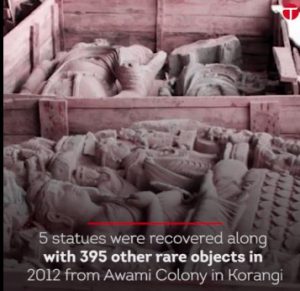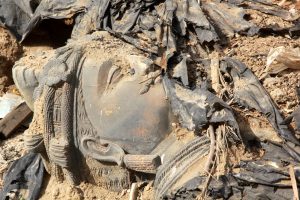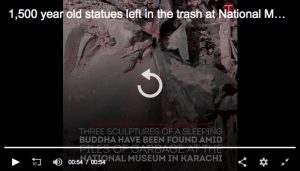The fate of ancient Buddhist artifacts in Pakistan’s museums once again made headlines after Gandharan period stone statues were discovered in a rubbish pile, visible from the street, at the National Museum in Karachi, Pakistan. The statues, which are said to be from the 3rd-5th century, have traveled from their original site, somewhere in Northwest Pakistan, to the Awami Colony in Karachi, where they were recovered from a Pakistani smuggling ring in 2012 , and finally to a trash heap at the National Museum. Two of the five statues were used to decorate the doorway of the antiquities director-general’s personal office, the others were tossed into a rubbish heap outside. There was no information on what happened to the other 390 “rare objects” recovered in the Awami Colony raid.

Screenshot from video of highly publicized seizure in 2012
The museum left the sculptures in the trash heap despite thinking that the works were authentic. It simply did not bother to care for them. Stated National Museum director Mohammad Shah, “We believe this sculpture dates back 1,500 years and it will be given an original look when we wash it.”
The five Buddhas, ranging between three and four feet in height, are made of black schist stone. Questioned by Hafeez Tunio in The Express Tribune, the director said, “We have put these sculptures over there ourselves.” He claimed that they were naturally protected from the elements by the black schist stone they were constructed from.
Tunio writes:
“Unfortunately, these sculptures are facing the same fate as hundreds of other artefacts and dozens of archaeological and heritage sites, which are in an absolute shambles due to the archaeology and antiquities departments’ neglect.”
According to an employee at the National Museum in Karachi, who requested anonymity, the treatment of the Buddhist statues highlights the general neglect of antiquities and cultural heritage sites rampant under the archeology and antiquities departments of Pakistan. Not only these statues, but many other artifacts have been neglected and improperly stored. The employee elaborated, “no one has looked after them for years and many are now rusted and stained. I cannot tell you how pitiful the condition of the rare objects inside the museum is.”
It seems that the items in this case were lucky even to make it to the museum’s garbage pile. Other seized antiquities from 2012 were smashed while in police custody. There, according to the Express Tribune, sweating laborers argued whether the items were Hindu or Buddhist, ignoring the fact that their rough handling was breaking them:
“The work, which began at about 8am turned the Awami Colony police station into a mangled museum of Gandhara art of over 30 pieces. “We’ll open a museum right here,” joked one of the police officers. “Here, you want to take one home?”

Gandharan head in trash heap
A Committee for Cultural Policy article, The Dolorous Case of Pakistan’s Museums, April 8, 2016, noted that:
“Despite the hard work of a small number of dedicated academics and archeologists, museums and ancient monuments in Pakistan are generally as moribund as cemeteries for art and artifacts. Pakistan’s cultural institutions have also been victims of the cupidity of several generations of corrupt officialdom. In March 2016, the anti-corruption department in Peshawar announced that it was launching an investigation into the replacement of original sculptures and coins from the Peshawar Museum by fakes.”
However, as CCP stated earlier, the 2016 investigation was too little, far too late. Visiting foreign experts have long held that a good portion of the important Buddhist sculptures in the Peshawar museum had already been replaced by fakes in the 1970s and 1980s.
Neglect within Pakistan’s government museums is an even greater concern than rampant theft. In July 2015, artifacts from the Moenjodaro and Mehrgarh civilizations at the archaeology department in Karachi were dumped into open boxes awaiting transport to the National Museum. According to Pakistan national newspaper Dawn, archaeologists were alarmed by the abrupt transfer of archaeological collections and a valuable library of rare books to the National Museum:
“There were boxes lying on the dusty floor. It looked like as if someone had packed them in haste. If there were artefacts in the cartons in which products of daily use are normally kept, it’s a terrible mistake because experts believe that the department is in possession of objet d’art and other articles dating back to ancient times.
The boxes were lying in the middle of a large room that looked like a badly kept library. It is not. The books are no less valuable than the artefacts. According to the person who was at the branch at the time and did not wish to be named, the books belonged to the federal government. In one corner, one could see broken pieces of pottery. It seems they are part of the materials found by local and foreign archaeologists over the course of their excavations and got damaged while being removed to be transferred to another site.”
Despite years – even decades – of past promises to reform, Pakistan’s government appears to lack any commitment to preserve and defend its archaeological resources, or to support the work of Pakistani and foreign archeologists in the country.

Screenshot from video of highly publicized seizure in 2012
 Pile of statues under rubbish outside museum
Pile of statues under rubbish outside museum 

